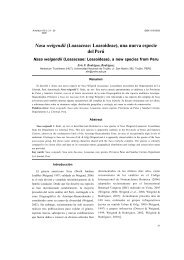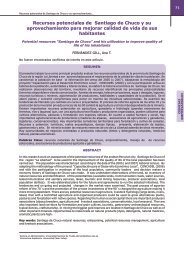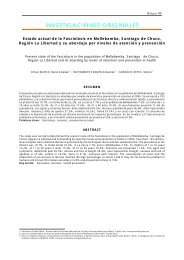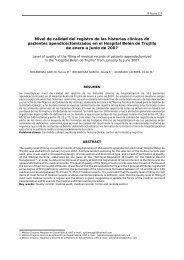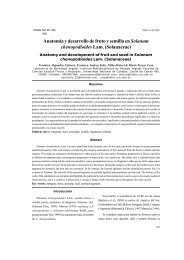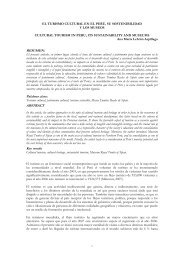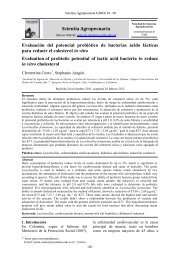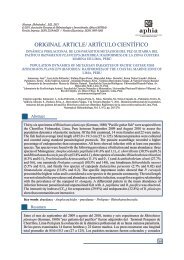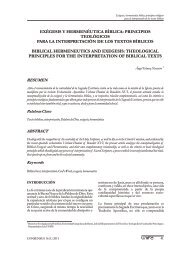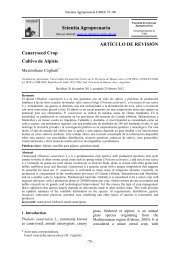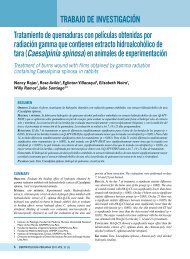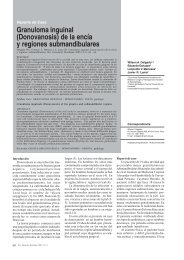New host records of Prosthenhystera obesaMartins et al.ResumenProsthenhystera obesa (Diesing, 1850) (Digenea, Callodistomidae) parasita <strong>la</strong> vesícu<strong>la</strong> biliar <strong>de</strong> lospeces <strong>de</strong> agua dulce y se encontró por primera vez en Leporinus reinhardti Lütken, 1875(Characiformes, Anostomidae) y en Pimelodus pohli Ribeiro & Lucena, 2006 (Siluriformes,Pimelodidae). Estos peces omnívoros se colectaron en <strong>la</strong> parte alta <strong><strong>de</strong>l</strong> río São Francisco, MinasGerais, Brasil. La prevalencia (%) y abundancia media <strong><strong>de</strong>l</strong> parasitismo por P. obesa fue 1,58% y 0,02 ±0,12 en L. reinhardti, y 3,85% y 0,04 ± 0,19 en P. pohli, respectivamente. Prosthenhystera obesa ya hasido registrado en un carnívoro characido Salminus franciscanus Lima & Britski, 2007 y en unomnívoro pimelódido Pimelodus macu<strong>la</strong>tus Lacepè<strong>de</strong>, 1803, los dos <strong><strong>de</strong>l</strong> río São Francisco, pero susparámetros ecológicos son presentados aquí por primera vez junto con los datos <strong>de</strong> L. reinhardti y P.pohli, dos nuevos hospe<strong>de</strong>ros <strong>de</strong> <strong>la</strong> región Neotropical. Los <strong>de</strong>scriptores ecológicos <strong>de</strong> P. obesa fueronsimi<strong>la</strong>res, en otras pa<strong>la</strong>bras, fueron bajos en todos los peces <strong><strong>de</strong>l</strong> río São Francisco y también en <strong>la</strong>mayoría <strong>de</strong> los peces <strong>de</strong> diferentes cuencas hidrográficas, <strong>de</strong> acuerdo con <strong>la</strong> revisión <strong>de</strong> <strong>la</strong> literatura. Se<strong>de</strong>staca que a pesar <strong>de</strong> <strong>la</strong> variabilidad morfométrica <strong>de</strong> P. obesa, los especímenes adultos con huevos seencuentran principalmente en los peces characidos, en particu<strong>la</strong>r en los ictiófagos, carnívorossuperiores <strong>de</strong> <strong>la</strong> ca<strong>de</strong>na alimentaria.Pa<strong>la</strong>bras c<strong>la</strong>ve: Characidae - Digeneos - Leporinus reinhardti - Pimelodidae - Pimelodus pohli.INTRODUCTIONDiesing (1850) <strong>de</strong>scribed Distomum obesum fromgall b<strong>la</strong>d<strong>de</strong>rs of Salminus brevi<strong>de</strong>ns, Leporinusfri<strong>de</strong>rici and Xiphostoma cuvieri collected byJohann Natterer during his expedition in Brazil inthe early eighteenth century (between 1817 and1835) along with several specimens sent and<strong>de</strong>posited in the Museum Caesareae, Vienna,Austria (“Naturhistorischen Museum”). InDiesing (1855) information about D. obesum wasthe same, but the localities and the date ofcollection for these hosts were specified: S.brevi<strong>de</strong>ns (= Salminus brasiliensis (Cuvier, 1816)according Géry & Lauzanne (1990); cited as“Salmo Nr. 9”, p. 9, and Salmini brevi<strong>de</strong>ntis too,Fig. 11-13, in the Table III, p. 12), from Cuyaba(State of Mato Grosso) in 26, 29 November 1824;L. fri<strong>de</strong>rici (Bloch, 1794) from Mato Grosso (citedas “Piaba” too, p. 9), in 30 October 1826, and X.cuvieri (= Boulengerel<strong>la</strong> cuvieri (Spix & Agassiz,1829) according Vari (2003); cited as “SalmoPirapucu” too, p. 9), from Rio Branco (river ofState of Roraima, inclu<strong>de</strong>d by the authors), in 5June 1832.Travassos (1920) proposed Callodistomidae andProsthenhystera allocating D. obesum in it, as<strong>de</strong>scribed by Travassos (1922a) from specimenscollected of S. brevi<strong>de</strong>ns (= Salminus franciscanusLima & Britski, 2007 according to Lima & Britski(2007)) from Lassance, Minas Gerais, in the SãoFrancisco River.The morphometric variability of specimens ofProsthenhystera obesa (Diesing, 1850) fromseveral hosts was presented by Kohn et al. (1997).Despite this morphological investigation,Callodistomidae was consi<strong>de</strong>red enigmatic andinclu<strong>de</strong>d by Bray (2002) in Gymnophalloi<strong>de</strong>a,because of taxonomic convenience based onmorphological analysis of adults. Callodistomidaewas relocated in Gorgo<strong>de</strong>roi<strong>de</strong>a, Subor<strong>de</strong>rXiphidiata by Olson et al. (2003) amongP<strong>la</strong>giorchiida, after analysis of gene sequences ofsmaller ribosomal subunits of nucleic acids and32
Neotrop. Helminthol., 6(1), 2012because the cercariae have stylets to penetrate theintermediate host. According to Olson et al.(2003), representatives of Gorgo<strong>de</strong>roi<strong>de</strong>a in<strong>vol</strong>vea wi<strong>de</strong> variety of hosts, that is, using aquaticmolluscs whose <strong>la</strong>rvae can e<strong>vol</strong>ve in terrestrialtetrapods in their cycles and can use terrestrialhosts in the entire vital cycle. Families exclusivelyparasites of fish and Brachyc<strong>la</strong>didae were locatedIn Allocreadioi<strong>de</strong>a, whose species parasitizemarine mammals. Recently, Petkevičiūtė &Stanevičiūtė (2008), combining morphologica<strong>la</strong>nd molecu<strong>la</strong>r data of adult specimens and the<strong>la</strong>rval characters of various species avai<strong>la</strong>ble(Curran et al., 2006; Choudhury et al., 2007) with akaryotype analysis of three species located in theAllocreadiidae intramolluscan stage common inthe Palearctic region, suggested highere<strong>vol</strong>utionary simi<strong>la</strong>rity between Allocreadiidaeand Callodistomidae and Gorgo<strong>de</strong>ridae(Gorgo<strong>de</strong>roi<strong>de</strong>a) than Allocreadiidae andOpecoelidae, currently p<strong>la</strong>ced in Allocreadioi<strong>de</strong>a.These authors pointed out that the karyotypeanalysis of species will assist in interpreting there<strong>la</strong>tionships between families and genera of thesedigeneans.The unknown life cycle of the species inCallodistomidae and ignorance of the life historyof P. obesa, with the exception that the specimensin the adult stage parasitize the gall b<strong>la</strong>d<strong>de</strong>rs offreshwater fish, provi<strong>de</strong>d motivation for furtherinvestigations on P. obesa parasitism in freshwaterfish. Besi<strong>de</strong>s the uniqueness of parasitism by thesehosts, according to Pavanelli et al. (1992),pathology caused in fish would occur by gallb<strong>la</strong>d<strong>de</strong>r rupture with reduced capacity for storageof bile by the host and possible intake of hematinpigments by the parasite.According to the records P. obesa has a wi<strong>de</strong>distribution in Characiformes in Brazil:Characidae - Salminus maxillosus (= Salminusbrasiliensis (Cuvier, 1816) according Vari (2003),by Travassos (1922a) and Isaac et al. (2000),Salminus hi<strong>la</strong>rii Cuvier & Valenciennes (= S.hi<strong>la</strong>rii Valenciennes, 1850) by Kohn et al. (1997),Astyanax bimacu<strong>la</strong>tus (Linnaeus, 1758) andAstyanax fasciatus (Cuvier, 1819) by Travassos &Freitas (1941), Galeocharax humeralis(Valenciennes, 1834) by Travassos & Kohn(1965), Brycon sp., Cynopotamus amazonum(Günther, 1868) and Caranx gibbosus (Linnaeus)and Triurobrycon lundii Reinhardt by Kohn et al.(1997), <strong>la</strong>ter nominal taxa not found in FishBase;Cichlidae – Cich<strong>la</strong>soma bimacu<strong>la</strong>tum Linnaeus,1758 by Travassos (1940); Anostomidae -Leporinus sp. by Travassos (1922b), Leporinuscope<strong>la</strong>ndii Steindachner, 1875 by Travassos &Kohn (1965) and Leporellus vittatus(Valenciennes, 1850) by Kohn et al. (1997);Sciaenidae - Pachyurus squamipinnis (sic) (=Pachyurus squamipennis Agassiz, 1831) by Kohnet al. (1997); and in Siluriformes: Pimelodidae -Pseudopimelodus zungaro (Humboldt, 1821) byTravassos (1922a) and Travassos et al. (1928),Pseudopimelodus roosevelti (= Pseudop<strong>la</strong>tystomamangurus (Valenciennes, 1835) by Travassos et al.(1928), Pimelodus c<strong>la</strong>rias Linnaeus (probablyPimelodus c<strong>la</strong>rias macu<strong>la</strong>tus, a junior synonymyof P. macu<strong>la</strong>tus Lacepè<strong>de</strong>, 1803 according toFishBase) and Pimelodus fuer (sic) [= Pimelodusfur (Lütken, 1874)] by Travassos et al. (1928) andTravassos (1940), respectively. In the SãoFrancisco River basin, P. obesa was recor<strong>de</strong>d inAcestrorhamphus sp. by Travassos (1922a),Salminus brevi<strong>de</strong>ns [= S. franciscanus accordingLima & Britski (2007)] by Travassos (1922b),Pseudop<strong>la</strong>tystoma corruscans (Spix & Agassiz,1829) by Kohn et al. (1997), Salminus brasiliensis[= S. franciscanus according Lima & Britski(2007)] by Brasil-Sato (2002) and P. macu<strong>la</strong>tus byBrasil-Sato & Pavanelli (2004).Several species of fish from the upper SãoFrancisco River, Minas Gerais, Brazil, had theirendoparasitic fauna recently investigated:Characiformes, Characidae - Salminusfranciscanus by Brasil-Sato (2002), Myleusmicans (Lütken, 1875) by Brasil-Sato & Santos(2003), Serrasalmus brandtii Lütken, 1875 andPygocentrus piraya (Cuvier, 1819) by Santos(2008), Tetragonopterus chalceus Spix & Agassiz,1829 and Triportheus guentheri (Garman, 1890)by Albuquerque (2009); Doradidae -Franciscodoras marmoratus (Lütken, 1874) bySantos & Brasil-Sato (2006); Cichlidae - Cich<strong>la</strong>33
- Page 1: Neotrop. Helminthol., 6(1), 2012201
- Page 5 and 6: Neotrop. Helminthol., 6(1), 2012Tab
- Page 7 and 8: Neotrop. Helminthol., 6(1), 2012unk
- Page 9 and 10: Neotrop. Helminthol., 6(1), 2012Par
- Page 11: Neotrop. Helminthol., 6(1), 2012*Au



